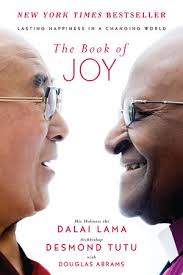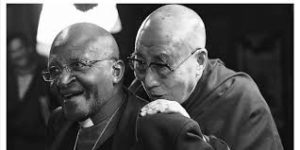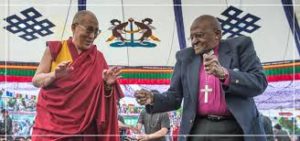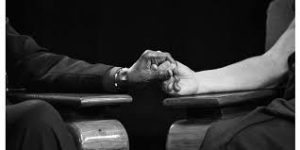The Book of Joy
I sometimes think of myself as a spiritual magpie, always on the lookout for a bit of inspiration. If you visit my “nest” you will find the words of Jesus, lovely psalms, letters from St. Paul, commentaries from Thomas Merton, Barbara Brown Taylor and C.S. Lewis, even the poetry of Rumi. Glance left and right and you’ll see candles flickering, jars of holy Lourdes water, a couple of yoga mats and an app for meditation. Woven in are memories of experiences at Vanderbilt Divinity school, a healing ministry at Woodmont, a stay at a Franciscan Monastery and several dips in the holy healing waters of Lourdes. My spiritual abode is strung luminous with scraps of paper, covered in prayers written in my own hand. Intertwined are precious photos of my husband and children who have taught me much about love. You see, I am truly a magpie—a consummate gatherer of all things sacred.
Each of us in our own unique way are scavenging our lives for twigs of wisdom to help build a safe haven for ourselves in the world. It is in the searching for the deeper spiritual truths that we begin to find answers for the Who am I? Who is God? What is my purpose here? questions of our souls. In this spirit, I offer you one of my best “magpie” finds, The Book of Joy by the Dalai Lama and Archbishop Desmund Tutu. Not only does this 350 page love letter offer a surprisingly intimate, endearing, often humorous revelation of two of the most remarkable spiritual leaders of our time, but its luminous message will speak directly to your heart.

The Book of Joy opens as a plane lands in Dharmasala, India, the home-in-exile of the Dalai Lama. His Holiness is celebrating his 80th birthday and he’s invited his good old pal and “mischievous spiritual brother,” Archbishop Desmond Tutu, to spend the week with him reflecting on the secrets to everlasting happiness. Douglas Abrams, a close friend comes along on the journey to capture the adventure in pictures and words. He will do this with such skill that I felt as if I sat in the room with them as they sipped Darjeeling tea and nibbled on Tibetan flatbread.
These two giants among men, both octogenarians, are clearly dear friends. They feel the shadow of their mortality close by. Because of their abiding love for all of humanity they feel compelled, urgently, to share their hard-won wisdom on the way to find joy in the short span of a life.

Between nuggets of insight these two men are refreshingly playful and approachable. They tease and tell jokes, they enjoy a nice rum and coke and rice pudding. But they also embrace each other with tears and tender glances. In one of the most beautiful scenes of their encounter, the Dalai Lama turns to the Archbishop and says, “I hope it is your face that I see at my death.” It leaves the Archbishop and the reader speechless. Could there be a more moving expression of love?

The Dalai Lama invites us into his inner sanctum where he meditates five hours a day. The description of his altar reminds of a magpie’s sacred nest with a statuette of the Madonna, a marble crucifix, a cerulean blue globe on a gold stand alongside his eclectic collection of buddhas. Together, one a Buddhist, the other a Christian, they meditated, prayed and shared the sacrament of Communion. Whatever your spiritual leanings, you will feel blessed by their willingness to pull back the veil on the intimate spiritual practices which have nourished their own souls over a lifetime.
Desmund Tutu proclaims, “Joy is our birthright.” The Dalai Lama reiterates this truth. He says, “From the moment of our birth, every human being wants to discover happiness and avoid suffering.” Certainly these two have known much pain in their individual lives. But there is no sense of defeat in their remembering of past hardships. The Dalai Lama has lived for 56 years in imposed exile from his home, family and kingdom. The Archbishop endured years of terror, imprisonment and violence in his fight against apartheid in South Africa. Many times they could have taken an easier route, thrown up the white flag of defeat and succumbed to sorrow. Instead they girded their courage, held fast to a “dogged sense of hope,” and trusted that redemption would come. Sadly, most of us undermine our own happiness. We create or destroy it within ourselves. Desmund Tutu gently states, “We must look inside.”
The Archbishop said, “Discovering more joy does not, I am sorry to say, save us from the inevitability of hardship and heartbreak. In fact, we may cry more easily, but we will laugh more easily too. Perhaps we are more alive. Yet as we discover more joy, we can suffer in a way that ennobles rather than embitters. We have hardships without becoming hard. We have heartbreaks without being broken.”
After my third reading of this book, I have come to understand joy as a spiritual discipline. These two amazing spiritual men teach joy as a practice, a catechism. Together they compiled a list of eight secrets to living in the stasis of joy regardless of life’s vicissitudes. With the use of metaphor and parables interwoven with their own life experiences, even the science behind joy, these sages reveal how to practice perspective, humility, humor, acceptance, forgiveness, gratitude, compassion and generosity.
I especially enjoyed the Dalai Lama’s metaphor of the axle on a horse-drawn cart. He says life is much like the dusty and unpaved roads of India. There are many a rut and pothole. Whether our journey is bumpy or smooth is determined by the strength of our inner axle (mind & heart). A team of neuroscientists and psychologists found the secret to our lasting wellbeing is our ability to reframe life’s situations more positively, our experience of gratitude and our choice to be kind and generous.
We must never underestimate the strength we bear within us; our capacity for resilience, compassion, hope and sacrificial love. Ultimately, the greatest hope is that we live in such a way that our lives shine with meaning.
Pinned to my computer is the Archbishop’s rallying call, “I believe with a steadfast faith that there can never be a situation that is utterly, totally hopeless. Hope is very close to unshakable. To choose hope is to step firmly forward into the howling winds, baring one’s chest to the elements, knowing in time, the storm will pass.”
“Every day is an opportunity to begin again.” That, from the Archbishop, is my new mantra. We are each learning how to be human. We accomplish this not in isolation, but together. In the end the fastest way to experience joy for ourselves is when we make possible joy for one another.
 Live in Hope,
Live in Hope,
Farrell
This week I was invited to be the guest writer at BaconOnTheBookshelf.com. My friend and the curator of Bacon on the Bookshelf, Jennifer Puryear, has created a name for herself in literary circles for her exceptional review of books from poetry, thought-provoking fiction, delicious beach reads, the crème of nonfiction and books that speak deep truths to the heart. Whatever she recommends in her virtual bookstore inevitably finds its way to my bedside table. She is also my “go to” for the incredible art scene in Nashville. Sign up for her weekly email and you will suddenly be “in the know” for incredible New York Times best-selling author events at Parnassus, the Nashville Ballet’s latest production and the best at the Schermerhorn. Also, make sure you don’t miss her Summer must reads!


Sorry, the comment form is closed at this time.